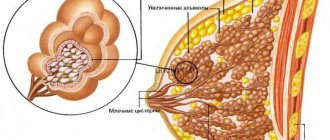The color and consistency of vaginal discharge are an indicator of women's health. Transparent or light white discharge is normal and indicates the functioning of the reproductive system. Often, girls notice pink discharge in the middle of their cycle. This phenomenon may indicate both a hormonal surge and other serious pathologies. In some situations, pink discharge is caused by a natural process in the body, and therefore does not pose a serious threat to the girl’s health.
Pink discharge before menstruation
Normally, vaginal mucus is completely transparent and may have a whitish or grayish tint. Pink discharge before menstruation or during another period of the cycle is explained by the presence of blood in the substance. The genital organs are an area of active blood circulation, penetrated by a network of tiny vessels - capillaries. Any violation of the integrity of their walls leads to blood leakage. At the end of the menstrual cycle, when the uterine cavity is lined with a thickened layer of the endometrium, ready for rejection, such a process is quite normal. Pale pink discharge that appears 2 days before menstruation is in most cases a harbinger of imminent menstruation, since the endometrial capillaries are very fragile and burst at the slightest movement. The ichor may look like slightly colored translucent mucus without any foreign odor or smell a little like iron. As a rule, at this time the girl experiences characteristic changes in her health: a feeling of fullness, heaviness in the lower abdomen, dizziness, some may experience a slight weight gain, mood swings, and others. Pink discharge before menstruation in this case is confirmation of a physiological process. Another sign of the norm is menstruation starting on time.
Pink discharge before menstruation can be caused by:
- intense sexual contact;
- routine examination in a gynecological chair;
- sports: , jumping;
- sudden movements, falls.
Normally, such signs 2 days before menstruation do not have massive blood clots, are not abundant, and are not accompanied by itching, irritation or redness in the genital area. The onset of menstruation should also not have purulent clots, foamy, black, greenish impurities, or an unusual odor.
Pink or light scarlet discharge a week before menstruation may indicate both a variant of the norm and existing pathologies. If such a picture bothers you for the first time, does not cause any discomfort, or is associated with dizziness, frequent mood swings, weakness, you can assume a minor hormonal imbalance due to stress, sudden eating disorders or physical activity.
Other possible causes of this condition are:
- consequences of medical procedures and operations;
- intrauterine device;
- current pregnancy;
- gynecological diseases.
The presence of a foreign body in the uterine cavity, which is an IUD, leads to regular trauma to the endometrium. A variant of the norm, depending on the individual characteristics of the body, is pink discharge of varying intensity that appears before menstruation. Typically, menstruation in such cases lengthens and becomes more abundant.
Many therapeutic and diagnostic procedures are associated with damage to the mucous membranes of the vagina, cervix or uterine cavity. The consequence may be slight spotting a few days before menstruation.
Many women experience pink discharge from the genital tract when their periods are delayed. The reason may be implantation of the embryo into the endometrium. Therefore, if such a condition occurs for the first time, it is necessary to take a pregnancy test or take a blood test for hCG.
The second phase is ovulation
The second phase of the menstrual cycle is quite short, but at the same time very significant. Ovulation is the achievement for which the menstrual cycle actually exists. It is intended for the possibility of fertilization and the realization of the main purpose of a woman - procreation. The ability and possibility of fertilization is possible within just 48 hours, and sometimes less. During this short period of 2 days, the woman’s reproductive system faces a responsible task, and if fertilization does not occur, the egg dies.
An increased concentration of luteinizing hormone promotes enhanced maturation and subsequent release of the egg from the follicle. Under its influence, important processes occur that ensure the preparation of the endometrial walls. When the egg reaches full maturity and is ready for fertilization, the follicular vesicle ruptures and the full egg is released into the fallopian tube to fuse with the sperm. In the cavity of the ruptured follicle, intensive growth of the corpus luteum begins, which, in turn, intensively produces progesterone and provides favorable conditions for successful fertilization and implantation of the fertilized egg into the wall of the uterus. The next cycle can have 2 outcomes, depending on whether fertilization occurred or not.
Pink discharge instead of period
Failures and long delays in menstruation and pink discharge appearing instead are often associated with hormonal imbalance. He is called:
- taking oral contraceptives;
- ovarian dysfunction;
- inflammatory diseases of the appendages;
- antibiotic therapy.
In situations where pink discharge occurs instead of menstruation, the process of normal growth of the endometrium or its rejection is disrupted. If this occurs while using hormonal contraceptives, there is no cause for concern. The establishment of a new cycle is not always associated with severe bleeding; often in the first 2–3 months, ichor is released instead of menstruation.
Pink discharge instead of menstruation is possible with the development of cystic formations in the ovaries and associated failures in estrogen production. Such situations can be protracted, accompanied by amenorrhea, oligomenorrhea - the complete absence of menstruation for several months or their rare occurrence.
Adnexitis, salpingitis or oophoritis - inflammation of various parts of the fallopian tubes, leading to disruption of their patency, are also associated with pink discharge and a simultaneous delay in menstruation. The diseases are often accompanied by severe pain in the lower abdomen and fever. The consistency of the discharge is usually dense, sometimes with yellowish or light brown clots.
Nature of the discharge
Sometimes the cause of the problem can be determined by the nature of the vaginal discharge. The secretion can take on light brown or black shades and appear in scanty or abundant quantities. If the pathology is caused by diseases, then the woman, in addition to a change in the color of the discharge, may notice other unpleasant symptoms.
Dark brown color
The presence of dark streaks in vaginal secretions is not the norm. The lighter the shade of mucus, the safer the condition for the girl. Dark brown secretion, not associated with menstruation, appears when taking oral contraceptives. This is the case when you need to stop taking OK and urgently consult a doctor to change the drug.
Another dangerous condition that leads to dark brown smears is cysts and benign tumors in the reproductive system. Neoplasms affect one or both ovaries at once. The diseases are additionally accompanied by instability of menstruation and problems conceiving a child.
Light brown color
The appearance of pink spotting and light brown secretion is the first sign of pregnancy. It appears due to the attachment of a fertilized egg to the walls of the reproductive organ. Usually the condition is not accompanied by other alarming signs. Other pregnancy symptoms appear several weeks later.
Another cause of light brown spots on underwear is the use of contraceptives. Mucus turns red due to changes in hormone levels in the body. Ladies notice a similar symptom after the installation of an intrauterine device. At first, the body perceives the spiral as a foreign body. Vaginal secretions turn beige or light brown due to irritation of the mucous membranes. The symptom goes away on its own within a maximum of 3 months after installation of the IUD. If this is not observed, then the woman should consult a gynecologist.
Constant daub
The cause of persistent brown leucorrhoea is numerous diseases of the genital area. You will not be able to determine the cause of the symptom on your own. This is due to the fact that it occurs against the background of numerous pathologies:
The listed diseases are accompanied by a pronounced inflammatory process. They develop due to the entry of pathogenic bacteria into the uterine cavity and nearby organs: streptococci, staphylococci, E. coli.
Pink discharge mid-cycle
In some women, slight pink discharge that appears in the middle of the cycle indicates ovulation has occurred - the maturation of the egg and its release from the ruptured follicle. This period, which usually falls on the 12th–13th day from the beginning of the next menstruation and several days before and after, is most favorable for conceiving a child. Sometimes girls feel increased sexual desire, their sense of smell and taste become more acute. Indigestion and bloating may occur. The discharge during ovulation is liquid, mucous, and contains little blood. There are no purulent impurities, no foul putrefactive odor, no burning sensation. Such discharge during ovulation usually occurs constantly, but their amount decreases or increases depending on the time of year, diet, and physical activity.
Symptoms at different periods of the cycle
Normally, a reddish secretion appears during puberty, in the first months due to the placement of an intrauterine device and after surgical interventions. Usually the symptom appears from the first to the tenth day of the cycle due to pregnancy or serious hormonal disorders. Another dangerous cause of bright red secretion is endometriosis. If it appears immediately after the regulation, you must consult a doctor so that he can prescribe appropriate treatment in a timely manner or register the pregnant woman with an antenatal clinic.
Bleeding from days 11 to 16 occurs during ovulation. A visit to the doctor is not required if the symptom is not accompanied by other warning signs. Abundant unusual secretion appears in the middle of the cycle or its second half due to benign or malignant tumors.
Rarely, a symptom from the 21st to the 25th day of the cycle indicates normal processes in the body. Bloody secretion before menstruation occurs due to hormonal imbalances. A small daub is allowed from day 26. It is caused by the gradual detachment of the endometrium. In healthy girls, normal menstruation appears a few days after this.
Normally, women should experience any bleeding only during menstruation. An exception is ovulatory bleeding - scanty pink discharge in the middle of the cycle, which indicates the movement of a mature egg, which corresponds to the period of ovulation. But the reasons may also lie in inflammation, infectious diseases, tumors and other pathologies.
Pink discharge after period
The reasons that cause pink discharge after menstruation are varied and, unfortunately, most of them belong to the field of pathology.
A physiological sign is a blood-stained mucous substance from the genital tract during puberty or before menopause, when the body is under the influence of hormonal changes. In adolescents, juvenile bleeding can begin in a similar way.
Some contraceptives can also provoke a similar picture, so before using them you need to discuss all side effects with your doctor and take into account your existing health conditions.
During menstruation, the body experiences increased stress and is most vulnerable to various pathogens and infections. In addition, many chronic gynecological diseases are getting worse. Pink discharge that appears unexpectedly or periodically after menstruation, asymptomatic or accompanied by other warning symptoms, may be evidence of the following diseases:
- Pathologies of the cervical canal and cervix. Diseases such as cervical epithelial dysplasia and endocervicitis often cause acyclic thick whitish and bloody discharge that appears a week or later after menstruation. Mixing with blood from damaged capillaries, the substance becomes pink. In advanced cases, such daub contains purulent impurities and emits a putrid odor. Such pathologies are practically not accompanied by pain, since the cervical region does not contain nerve endings.
- Diseases of the uterine cavity. Pink discharge after ovulation may be a sign of endometriosis, polyposis, or uterine fibroids. In this case, both light and dark shades of daub are possible. The color and consistency are influenced by the internal microflora of the vagina, the location of the endometrial areas, the size and morphological characteristics of myomatous nodes. The release of clots is often accompanied by nagging or cramping pain in the abdominal cavity and physical weakness.
- Sexual infections are another reason why strange-looking discharge occurs after menstruation, including pink discharge. Exacerbation of ureaplasmosis, gonorrhea, trichomoniasis or chlamydia is manifested by moderate or heavy discharge from the vagina. They often begin at the end or immediately after menstruation, have a strong unpleasant odor, and can be foamy and liquid. Other symptoms accompanying STDs: low-grade fever, redness and swelling of the genital tract, severe itching, burning.
- Pink discharge after ovulation is possible in the presence of systemic diseases: chronic diabetes mellitus, hypothyroidism, immunodeficiency states, hematopoietic dysfunction. In such cases, it is necessary to conduct a comprehensive medical examination and correction of pathology.
Pink discharge during pregnancy
Pink discharge that occurs before your expected period is sometimes the first sign of pregnancy. They are typical for the second half of the cycle, after fertilization of the egg during the process of its attachment in the uterine cavity. Implantation of the embryo occurs with a violation of the integrity of the endometrium: it is embedded inside the layer of tissue, which causes the capillaries to rupture and a small amount of blood to be released. The smaller it is, the lighter the color of the secretion discharged from the vagina. Usually, a pregnant woman discharges a thick spotting substance in the early stages, the next menstruation does not begin, and the result of a test performed after 5–7 days is positive. To this are added other signs indicating pregnancy: nausea occurs in the morning, the mammary glands swell, and the lower abdomen feels a little tight.
If pink discharge appears due to a delay instead of menstruation, and the test is negative, you should contact the antenatal clinic and get tested or try again in 2-3 days.
Postpartum discharge, the so-called lochia, is also sometimes light pink in color. They are not associated with the menstrual cycle, but with the cleansing and contraction of the uterine cavity. In the first days, lochia appears in the form of dark bloody clots. They lighten closer to the end of the 6-week postpartum period.
Dependence of pregnancy signs on fetal development
The most basic changes in fetal development begin on days 21–22 of the cycle, and the first signs of pregnancy most clearly appear from this time.
The formation of the embryo's nervous system affects the change in the functioning of the expectant mother's taste buds.
The spinal cord, brain and heart muscle, developing in the womb, bring headaches to the woman, the sense of smell becomes acute, and the woman begins to be irritated by pleasant odors.
The level of hormonal changes on days 22 - 23 increases salivation, a state of mild nausea in the morning is the first sign of successful conception. After this period, the pregnancy test for some girls may slightly color the second strip.
From about 27 - 28 days the signs become increasingly brighter. Certain eating habits appear, the woman is disoriented, she is confused by smells or attracted to them, even by those that she had not noticed in the recent past. She often refuses to eat her usual food. Spicy and salty foods are attractive.
This is how the body reacts to a lack of vitamins, microelements, and minerals necessary for the development of the fetus. A planned pregnancy should focus on consuming only high-quality and healthy products from the first days.
If your period is late, you need to check your assumptions about a successful conception using a test. After 2 days, repeat testing is simply necessary if the first attempt did not give a solid result.
Primary signs and a positive test are an almost 100% guarantee of motherhood. A visit to the doctor will be necessary, and the sooner, the calmer the mother will be about the future life of the little man.
Each representative of the fair sex has to deal monthly with the phases of her menstrual cycle, with their own characteristics and characteristic symptoms. These phases are significant stages that are responsible for the reproductive function of the female body. The duration and nature of the menstrual phases are largely individual, but the basics and order of their occurrence remain unchanged and have their corresponding names. This entire significant process is cyclical, and begins with the arrival of menstrual bleeding, which is considered to be the first of the three phases of the menstrual cycle.
Any girl or woman in the age range from puberty to menopause must understand the work of her body and understand the purpose of all three phases of the menstrual cycle. With the help of this knowledge, you can easily calculate the favorable period for conceiving a child or, on the contrary, protect yourself from unwanted pregnancy and some health problems.
Pink discharge due to thrush
Vaginal candidiasis or thrush is the most common disorder of internal microflora, according to medical statistics. Candida fungus is a conditional pathogen that multiplies during weakened immunity, frequent hypothermia, after taking antibiotics or in stressful situations. The main manifestations of candidiasis are profuse or moderate leucorrhoea of a cheesy structure with a characteristic sour odor. They may be accompanied by severe itching and discomfort.
Pink discharge with thrush is also likely. Blood appears:
- due to severe irritation and excessive desquamation of the vaginal mucosa;
- after another examination by a gynecologist in the chair;
- due to too intense douching;
- due to the addition of a secondary infection.
During an exacerbation of thrush, the mucous membrane is very vulnerable and easily injured. If whitish discharge appears against the background of dysbacteriosis, it is possible to determine what it may be only after a qualified examination. Especially if the condition is accompanied by pain or other negative symptoms. Sometimes a tumor or serious inflammatory process can be hidden under banal candidiasis.
What to do if you find pink vaginal discharge? What could be the cause of the discharge and how dangerous can it be for the female body?
What types of pink discharge are there?
Pink vaginal discharge can have a different consistency: from liquid to thick (curd-like). They also differ in color and can be from pale pink to bright red. At the same time, the symptoms of discharge can also have a different character and proceed in different ways.
The shade of the discharge depends on how much blood and vaginal secretion mixes with each other. Vaginal discharge can be of the following colors:
- pinkish, most often formed after menstrual periods;
- pinkish-brown, may occur mid-cycle;
- white or colorless with a pungent odor;
- bloody (not menstrual), occur long before the onset of menstruation;
- curdled, usually white or gray in color with a strong unpleasant odor;
- transparent, often reminiscent of urine discharge.
Any of these types of discharge may indicate the onset of some serious female disease or hormonal imbalance. The sooner you find out the cause of these diseases, the faster you can undergo treatment and prevent serious complications.
What causes pink vaginal discharge?
Pink discharge from the vagina is a consequence of changes in the functioning of the uterus. What changes occur in the uterus when you observe pink discharge? As the egg matures, the hormonal system changes and releases large amounts of estrogen.
This hormone begins to influence the cells of the uterus and prepares it to receive a fertilized egg. This happens because a certain amount of blood is secreted in the uterus, which mixes with vaginal secretions, as a result of which pink discharge can be observed in the middle of the cycle.
There are other reasons that can provoke such discharge. They are connected with the fact that as a form of contraception, women often install an intrauterine device, which can lead to bleeding due to growth into the uterus and subsequently, mixing with white vaginal secretion, give a similar shade.
Modern oral contraceptives can also have side effects in the form of pink discharge. Before using them, be sure to read the package insert so that this does not become a cause for concern later.
Surgery or a gynecological examination that may have damaged the uterus is another cause of pink discharge.
Natural factors that may cause such formations include residual blood in the uterus after menstruation. This is a normal natural process in which the uterus has not yet completely gotten rid of the remaining blood and releases it within 3-5 days.
However, if you find discharge that is dark in color and has an unpleasant, pungent odor, and is also accompanied by pain in the lower abdomen and lower back, you should immediately contact a gynecologist.
The cause of such phenomena may be untreated pathologies or the formation of malignant and benign tumors, such as cancer, cysts and others.
Various forms of viral and infectious diseases such as HIV, AIDS and others have similar symptoms. Therefore, it is imperative to insist on testing pink discharge.
During and after sex, a woman can observe similar phenomena. They indicate that there are microcracks in the vagina, which were caused by choosing the wrong position during sex or by using various objects that could cause physical injury.
Pink discharge from the vagina is associated with excessive intensity of sexual intercourse, as well as a discrepancy between the penis of the sexual partner and the partner’s vagina. This can lead to injury to the internal genital organs of the vagina, resulting in pink discharge.
In any case, if you feel discomfort during sex or notice bleeding after it, you need to reconsider your sexual behavior together with your partner. If you do not have such a conversation and measures are not taken, then the consequences can be very sad, even fatal.
A sexologist can help you deal with a number of sexual and psychological problems. The consultation you receive from him will help you avoid mistakes in sex in the future and learn to enjoy yourself in a different way.
Causes of pinkish-brown discharge
Below are the most common causes of pinkish-brown vaginal discharge.
Menstruation
Pinkish-brown discharge is often observed a few days before menstruation
Pinkish-brown discharge often occurs a few days before your period begins. They indicate that the body is preparing for menstruation.
Women may notice slight pink or brown discharge towards the end of their period. This symptom is also not associated with abnormalities, and therefore should not be a cause for concern.
Fresh blood is pink or red in color, but when the blood stagnates, it usually turns brown.
Cervical irritation
Pink, red, or brown vaginal discharge may cause irritation if the cervix bleeds a little. Sometimes this happens after vaginal sex or placing intimate toys and other objects into the vagina.
The cervix may become irritated due to injury, infection, or exposure to chemicals. In addition to vaginal discharge, in such cases women also experience itching.
Ovulatory bleeding
Ovulation is the process by which one of the ovaries releases an egg. In most cases, ovulation occurs in the middle of the menstrual cycle.
At this time, women may notice ovulatory bleeding, which is a slight light discharge of blood. In addition, cramps in the pelvic or abdominal area may be signs of ovulation.
Hypomenorrhea
Hypomenorrhea is characterized by. When a woman has this condition, she may see pink or brown discharge instead of her usual menstrual bleeding.
The length of a normal menstrual cycle ranges from 24 to 38 days, and menstruation is usually observed within 8 days. If a woman’s menstrual cycle does not correspond to these numbers, then it is called disrupted.
Breakthrough bleeding is more likely to occur in women who:
- missed an appointment, forgot to change the contraceptive patch or vaginal ring;
- gets sick or suffers from dehydration in the middle of the menstrual cycle;
- takes antibiotics;
- takes oral contraceptives continuously or takes long-term pills that reduce the frequency of menstrual bleeding to once every three months;
- uses ;
Hormonal imbalance
Hormones control the menstrual cycle and influence the nature of menstruation, so hormonal imbalance can cause changes in the color of vaginal discharge at different periods of the cycle.
Low levels of certain hormones sometimes cause the uterus to shed its lining differently, and women may experience pinkish-brown vaginal discharge.
Such discharge is often observed in women who are just beginning to experience menstruation. In addition, they arise when approaching.
Infections
Many infections, including those that are sexually transmitted, can cause pinkish-brown discharge.
These infections include the following:
- chlamydia;
- pelvic inflammatory disease (PID).
These infections can also cause other symptoms, including the following:
- pain in the pelvic area;
- painful urination;
- itching in the vaginal area;
- unpleasant odor from the vagina.
Each of the above infections requires medical attention.
Implantation bleeding
Implantation bleeding occurs when a fertilized egg or embryo implants in the uterus. Some women at this point may notice a slight pinkish discharge, which is sometimes accompanied by mild cramps.
Very often, the process of embryo implantation occurs on the days when menstruation should begin, so women confuse implantation bleeding with weak menstruation.
If conception has taken place, then along with implantation bleeding, a woman may experience other signs of pregnancy. These include the following:
- headache;
- nausea;
- breast tenderness;
- aversion to food;
- fatigue;
- aching back pain.
Ectopic pregnancy
Sometimes the fertilized egg implants outside the uterus. Usually in such cases it is attached to one of the fallopian tubes. If this happens, the embryo will not be able to develop correctly. In addition, with an ectopic pregnancy, a woman can develop serious complications.
One of the first signs of an ectopic pregnancy is usually vaginal bleeding, which may be pink or brown.
Bleeding may be heavier or lighter than normal menstruation. In addition, the following symptoms may appear:
- sharp stabbing pains;
- weakness;
- dizziness or lightheadedness;
- gastrointestinal problems.
If a woman suspects she has an ectopic pregnancy, she should see a doctor immediately.
Ovarian cysts
Symptoms of ovarian cysts include unusual vaginal discharge and pain and pressure in the lower abdomen
These are sac-like structures filled with liquid or semi-solid that develop in the ovaries. They usually bother women of childbearing age. often appear immediately after the ovary releases an egg and disappear during menstruation.
However, in some cases, cysts do not disappear, but continue to grow. If this happens, women may notice abnormalities in the nature of vaginal discharge.
Some women do not experience symptoms with ovarian cysts, while others, along with unusual discharge, may experience the following:
- pain and pressure in the lower abdomen;
- pain during sexual activity;
- feeling of fullness in the pelvic area;
- pain or pressure when urinating;
- nausea and vomiting.
Women with very large cysts may need medical treatment. This is often required for polycystic ovary syndrome.
Miscarriage
A miscarriage is a spontaneous termination of pregnancy before the 20th week of gestation.
In most cases, women who experience miscarriages experience brown bleeding and pink mucous discharge.
Miscarriages can happen very early after conception, when the woman has not even learned about pregnancy. Doctors call this condition chemical pregnancy.
In the first trimester, bleeding is observed in many women who do not have miscarriages, but if this happens, you should definitely tell your doctor about the problem.
Lochia
Doctors use the term “lochia” to describe vaginal discharge that occurs in women after childbirth.
During the first few days after your baby is born, vaginal discharge usually resembles a heavy period. They present as copious discharge of dark red blood with blood clots.
Later, the bleeding gradually weakens, and the color of the discharge becomes lighter. They first turn pinkish or brown and then creamy white or yellow.
What does discharge in the middle of the cycle mean?
Usually pinkish discharge occurs 2 weeks after menstruation during the period of ovulation. This indicates that the uterus is ready to accept a fertilized egg and you can begin to conceive. A woman receives such prompts from her body every month, and this can be regarded as a call for pregnancy.
Thus, nature itself took care of how to make the woman understand that her body is ready to receive a fetus. However, if the discharge is more red in color, this may be evidence that there is erosion in the cervix. At the first appearance of pink discharge, consult a doctor in a timely manner for advice, and the problem can be solved with medication.
Sometimes women notice that their discharge does not look quite normal. If there are no painful symptoms, then their appearance is not necessarily a sign of pathology. All processes of the cycle are controlled by hormones. Any shift in hormonal levels affects the functioning of the reproductive organs, the condition of the glands and blood vessels. This is what causes the faint color to appear. If it is pink, it indicates the presence of blood impurities, which is alarming. If you have any doubts about the origin of such discharge, you should visit a doctor and undergo an examination.
In the middle of the cycle, the discharge is thinner and more abundant than immediately after menstruation. Thanks to this, the mature egg moves freely from the ovary to the fallopian tubes. At the same time, the counter movement of sperm is facilitated.
Ovulatory bleeding
If the leucorrhoea in the middle of the cycle on some day becomes pale pink in color, and then again becomes colorless, reminiscent of egg white, this indicates that ovulation has occurred. When the follicular membrane ruptures, droplets of blood come out of the damaged capillaries and mix with normal mucus, giving it a faint pink tint.
This process was even given a special name “ovulatory bleeding.” Not every woman notices it, since there is no sensation of pain or other discomfort. But for those who are planning a pregnancy, pink discharge in the middle of the cycle is a sign that the most favorable days for conception have arrived.
Pregnancy
During pregnancy, pink discharge is also observed. Girls who are preparing to become mothers begin to worry a lot, not even suspecting that this symptom is not always pathological. Often, a pinkish tint forms during the first trimester when a woman gets her period. A small amount of discharge does not affect the health of the expectant mother and child. In this case, you need to visit a gynecologist and tell him about the changes.
Prolonged pink discharge, which is accompanied by painful sensations, itching and severe cramps, can provoke termination of pregnancy. In many cases, the appearance of pronounced symptoms is associated with a deficiency of the hormone progesterone. The development of pathology begins with pink discharge, and as it progresses, the discharge acquires a scarlet hue. The first step is to contact your doctor, who will take a blood test and determine the cause of the pathological changes.
Bright pink discharge during pregnancy is accompanied by a characteristic specific odor and severe itching. In most cases, the manifestation of symptoms is caused by an infectious disease, which poses a great threat to the development of the fetus. For an exact definition and cause, you must consult a doctor. After the examination, the doctor will prescribe therapeutic therapy, and thereby preserve the baby’s health.
When pink leucorrhoea is not a pathology
Do not be alarmed if spotting occurs between periods in a woman taking hormonal birth control pills. This happens for 3-4 months until the body gets used to the new hormonal levels.
Sometimes such discharge occurs after sexual intercourse. A reddish color appears if mucus production is insufficient, the walls and blood vessels are easily injured. The presence of blood may be facilitated by a decrease in blood clotting.
Warning:
If such discharge appears systematically after sexual intercourse, painful sensations occur, this may be a sign of endometriosis, diseases of the cervix. In this case, consultation with a gynecologist is necessary.
Video: Causes of spotting after sex
Discharge before and after ovulation by day
Discharge during menstruation in women lasts from 5 to 7 days. Immediately after the end of menstruation, the so-called dry days begin (8-11 days).
12-13 days. A watery secretion is indicated. It is sticky and not abundant (the beginning of the ovulation period).
Day 14 Mucus increases in volume and thins out.
15th day. Vaginal discharge becomes similar to egg white: it has no color and stretches between the fingers. Blood streaks may appear. (ovulation)
16th day. The secretion is still as copious as snot.
17-19th day. The consistency becomes denser. The secretion becomes cloudy and thickens (the fertile period ends).
20-28th day. There are no allocations.
Data by day are approximate and do not reflect the menstrual cycle of all women.
Yellow discharge after ovulation in a woman is a natural phenomenon that may indicate pregnancy.
Pink discharge as a sign of pathology
The appearance of such discharge indicates the occurrence of a hormonal imbalance. At the same time, the woman also develops other menstrual disorders (irregular rhythm, scanty periods). The development of the endometrium of the uterus is disrupted, which leads to its premature detachment and bleeding between menstruation.
The appearance of pink discharge in the middle of the cycle is possible with the following pathologies:
- Infectious diseases of the genital organs. A characteristic manifestation is a change in the consistency and smell of leucorrhoea. For example, with thrush, the discharge resembles cottage cheese and has a sour smell. With gonorrhea, pink discharge contains greenish mucus and smells rotten. Unlike normal ones, they cause pain and discomfort.
- Inflammatory diseases in the cavity and cervix, in the external genitalia.
- Pathological growth of the endometrium (hyperplasia, endometriosis), formation of polyps.
- Diseases associated with damage to the mucous membrane of the cervix (erosion, dysplasia).
- Ovarian cysts.
- Benign and malignant tumors of the uterus (fibroids, cancer).
The sooner pathologies are detected, the more successful the treatment will be. There are usually other painful symptoms that force a woman to see a doctor and undergo an examination. The hormonal background and the composition of the vaginal microflora are examined. Ultrasound and other instrumental methods are used to detect tumors in the uterus and ovaries.
Video: Diseases that cause bleeding between periods
The quantity and quality of secretion in the female vagina depends on the state of health and hormonal activity of the ovaries. In the absence of pathologies and dysfunctions of the genital organs, the discharge is transparent or white. Sometimes the secretion turns pink. Why does this happen?
Doctors' answers
How many days is your cycle? Brown discharge in the middle of the menstrual cycle may be a result of ovulation. These discharges can be either normal or manifestations of an inflammatory, dyshormonal process. If spotting precedes menstruation for more than 2 days, or brown, pink, red-brown discharge appears in the middle of the menstrual cycle, this most likely indicates a disease. Brown discharge before menstruation can signal: hormonal disorders, the presence of any infections (in particular, endometritis - inflammation of the endometrium), hematological diseases, adeomyosis. Very often, such phenomena accompany endometrial hyperplasia and endometrial polyps. In particular, brown discharge before menstruation in combination with other symptoms (pain during menstruation, heavy bleeding with clots for more than 7 days) are signs of endometriosis. Brown discharge mid-cycle may be a sign of progesterone deficiency or polycystic ovary syndrome, such conditions cause infertility and require treatment. To exclude a pathological cause for these discharges, it is advisable to undergo examination by a gynecologist: examination, colposcopy, ultrasound, examination for infections.
Brown discharge may be a sign of chronic endometritis - inflammation of the endometrium, the mucous membrane of the uterine cavity. Brown or bloody discharge are also the main symptoms of endometriosis of the cervix or uterine body. This does not necessarily cause pain. Spotting, bloody, brown discharge at the end of the cycle before menstruation or for a long time after menstruation may indicate endometrial hyperplasia. Therefore, to exclude this or that disease, you need to consult a gynecologist in person and undergo a full laboratory and diagnostic examination.
Svetlana
My cycle is not established, 5 months ago I saw a doctor who said that everything was normal for me, and I was prescribed Lindinet 20 for 3 months, I stopped drinking it 2 months ago. Over the course of a month I had an unprotected period several times
If the cycle is not established and the doctor said that everything is normal, then it could be either ovulation bleeding or implantation bleeding - they are similar in external manifestations. If you have had unprotected sexual intercourse, then in order to accurately understand whether you are pregnant or not, you need to donate blood for the hCG hormone - this method is the most reliable in the early stages of pregnancy. Blood can be donated 10 days after unprotected sexual intercourse. An increase in test units indicates pregnancy. The analysis is done in any commercial laboratory, blood is donated in the morning on an empty stomach. With the results of hCG, contact your gynecologist or write the result here, and I will tell you whether you are pregnant or not.
Svetlana
Good afternoon. My husband and I are in the process of conceiving a child. The last local ones were from 30.03 to 01.04. The cycle is approximately 30 days. 21.04 was p/a. Today, April 22, light brown spotting appeared in the afternoon. Should I worry?
If you are in the process of conceiving, if these are smears, if there is no red blood, if these discharges do not last more than two days - then for control, 10 days after the procedure, donate blood for hCG - this may be implantation during late ovulation.
Svetlana
On the 24th day of the cycle, spotting brown discharge with clots began, in small quantities, lasted for 1 day, there was no pain, fever, etc., I felt good, what could it be? Patient age: 17 years
Discharge with clots outside the cycle can be due to a polyp, endometriosis, or endometrial hyperplasia. The state of health does not change. To exclude a pathological cause for these discharges, it is advisable to undergo an examination by a gynecologist: examination, colposcopy, ultrasound is required, examination for infections as indicated.
Causes of pink discharge in women
A pinkish color of secretions before menstruation can be either normal or indicate the onset of a disease. In this case, one should take into account the volume, consistency, and the presence of additional symptoms (odor, itching or burning). If a girl has pink vaginal discharge a few days before the start of her period, and it does not cause any discomfort, this phenomenon is considered normal.
A common cause of pinkish secretion is taking hormonal contraceptives for a long time. Such drugs change female hormonal levels, as a result of which such uncharacteristic vaginal leucorrhoea occurs. In addition, the intrauterine device, which is installed to protect against unwanted pregnancy, can stimulate such changes. Another possible reason for the change in color of the secretion is the onset of pregnancy.
If you have pink discharge before your period (more than 2-3 days), you should immediately visit your doctor, as this may be a symptom of a serious illness. Neglecting your health leads to irreversible consequences and complications. Pinkish discharge before menstruation may also be a sign of:
- the presence of polyps on the genitals;
- hormonal disorders;
- endometrial hyperplasia;
- contracting an infection that is sexually transmitted or as a result of insufficient intimate hygiene;
- tumors;
- hematological pathologies;
- endometriosis.
Sometimes a pink secretion is released after sexual intercourse, as a rule, this indicates the presence of erosion in the cervix. If, after sexual intimacy with a man, a woman releases a small amount of blood, this could be caused by microcracks that appeared in the vagina due to too intense friction. In some girls, a pink secretion, similar to diluted blood, is secreted regularly after the end of menstruation - this is the main symptom of chronic endometritis or endocervicitis.
What is normal discharge before menstruation?
Before menstruation, hormonal changes begin in the female body, so leucorrhoea can change its character and become more abundant. Changes in hormonal levels, in addition, affect the microflora of the vagina and the properties of the secreted secretions. Before menstruation, vaginal leucorrhoea acquires a mucous or creamy consistency and a cloudy or yellowish color. Many girls note that at the end of the menstrual cycle, the secretion becomes more viscous and thick.
Pale vaginal leucorrhoea is considered normal if it is not accompanied by any symptoms such as burning or itching and has no odor. On the eve of menstruation, their number can increase several times. Pink discharge before menstruation is acceptable 1-2 days before the start of the cycle. If they occur earlier, the girl should consult a gynecologist.
Norm
In healthy women, the discharge before ovulation should be translucent, transparent or liquid, similar to egg white, slightly viscous. They usually have no specific odor, or have a slight one. Thus, the vaginal environment is favorable for sperm to move faster towards the target. Heavy discharge does not last long, about two days.
During ovulation, the female body undergoes some changes. This can be expressed by: painful sensations in the lower abdomen, chest pain, changes in taste, changes in hormonal levels. A characteristic symptom is vaginal discharge. Starting to appear some time before ovulation, they are transparent in appearance and have great viscousness.
After release, the eggs are more abundant than usual. They persist for several more days after the release of the egg, and correspond to the natural state. Later they become thicker and decrease in intensity. This can be explained by the fact that the work of progesterone (steroid hormone) is aimed at preserving the created fertilized egg. The mucus thickens under its influence, and its color may change. The color changes to reddish, yellowish, cream, beige.
The normal color of the discharge is:
- transparent appearance, with small streaks of blood;
- pink-beige, brownish;
- yellow, light yellow;
- brown smearing.
Pink-beige, brown are associated with the release of the finished egg. Brownish color - often occurs 7 days after ovulation. If there is no pathology, then it fits the norm and means a possible pregnancy.
Yellow, light yellow, without a pungent odor, itching or other discomfort, means that there are no violations. Usually appear under the influence of progesterone.
If such discharge does not have a bad odor, there is no painful sensation against it, its amount periodically changes slightly, and does not cause discomfort, then it is natural.
What diseases cause discharge?
If vaginal leucorrhoea has acquired a reddish, brownish or yellow impurity, it is thick or too abundant - this may indicate the progression of some pathology in the girl or infection of the genital organs. If these symptoms occur, you should visit a gynecologist. The specialist will conduct an examination and take a smear to identify abnormalities. The ease and speed of treatment directly depends on the timely diagnosis of the disease.
Discharge with a yellow tint
If a woman has yellow leucorrhoea before her period, this indicates the presence of an infection in the genitourinary system. As a rule, they are transmitted during sexual intercourse from a partner. A yellowish tint to the secretion can be caused by:
- chlamydia;
- vaginal dysbiosis;
- mycoplasmosis, etc.
Pink with scent
If a woman has pink discharge before her period, it has an unpleasant odor and a brown impurity - these are obvious symptoms of endometriosis. The disease is characterized by the growth of the endometrium on the inner walls of the uterus. This pathology worsens a woman’s condition during menstruation, causing pain. This disease requires hormonal therapy and, as a rule, surgery.
Pink discharge with an odor, in addition, may indicate the need to change the contraceptive. This indicates the ineffectiveness of the drug and incompatibility with your hormonal levels. Slight pink discharge and itching that appears instead of menstruation may indicate pregnancy. Implantation bleeding occurs when a fertilized cell attaches to the uterus. In this case, the discharge is not abundant and can have a color from pinkish to light brown.
Curdled
The appearance of pink discharge before menstruation often indicates the development of an infection in the woman’s genitals. In this case, the doctor diagnoses redness on the vaginal mucosa and the appearance of a whitish coating on them, reminiscent of cottage cheese in consistency. If the curdled discharge is pink, there is reason to suspect the development of thrush against the background of an erosive process in the uterus (in this case, the secretion is filled with blood clots). A fungal disease may be accompanied by a burning sensation, constant severe itching, and an unpleasant odor.
Candidiasis periodically develops in 9 out of 10 women, the reasons for this are varied:
- suppressed immunity;
- taking antibiotics or other potent medications that lead to dysbacteriosis;
- pregnancy;
- wearing underwear made of synthetic materials;
- negative impact of the environment;
- insufficient body hygiene;
- unbalanced diet;
- consuming large amounts of sugar, yeast dough, alcohol, too hot or spicy foods.
Pale, curdled vaginal leucorrhoea sometimes indicates the presence of more serious pathologies, including genital infections. They serve as a symptom of chlamydia, mycoplasmosis, ureaplasmosis. A yellow tint and lack of odor is observed with inflammation of the appendages, fallopian tubes, and ovaries. If pathologies such as salpingitis, adnexitis or oophoritis enter the acute phase, girls notice an increase in the amount of vaginal leucorrhoea with a cheesy consistency.
Mucus discharge
Heavy clear discharge in the middle of the cycle is normal. In this case, leucorrhoea is similar to egg white and has a mucous consistency. Pink discharge before the onset of menstruation sometimes indicates an erosive process or cervical cancer. Additional signs of this are the mucous consistency of the secretion and blood clots in it. If you notice such symptoms, you should immediately contact a gynecologist.
What should normal discharge be like?
Some types of vaginal discharge are natural. Moreover, they help maintain vaginal health by moisturizing the organ and protecting it from infections. Vaginal discharge also contributes to a woman's fertility.
Pink discharge in women can be for both harmless reasons and very dangerous for health. The information below should not be used to attempt to diagnose yourself. There's no need to guess. If the discharge continues for more than 1-2 days, and is quite heavy, you need to consult a doctor as soon as possible. And now the possible causes of pink discharge in women, which are most often diagnosed by gynecologists.
Vulvovaginitis and kraurosis of the vulva
This is an inflammation of the vulva and vagina. It occurs more often in girls before menarche and older women. It occurs due to pathogenic microorganisms that enter there from the intestines (most often), due to pinworms. This occurs with poor personal hygiene, frequent and active masturbation, and the insertion of foreign objects into the vagina. If any object remains in the vagina, this can cause sanguineous discharge.
Kraurosis of the vulva is more often a problem in older women, resulting from a lack of the hormone estrogen. For this reason, the vaginal mucosa becomes thinner and loses its protective properties. This is a precancerous disease that must be treated.
Body and cervical cancer
Knowing about the possibility of this, every woman should regularly, once a year, visit a gynecologist for a preventive examination. And if uterine cancer is more common in women over 50 years of age, then cervical cancer can be diagnosed in women in their thirties. Not long ago a big discovery was made. The causative agent of cervical cancer is certain types of papillomavirus. It is transmitted sexually and is very common.
Girls are recommended to get vaccinated against papillomavirus, thereby protecting themselves from cancer in the future. But nevertheless, whether the vaccination was done or not, whether papillomavirus is detected in gynecological smears or not, once a year every woman must take a smear, the so-called PAP test (cytology smear), and be examined by a gynecologist.
If the smear result is not very good, and even more so if there is pink discharge after menstruation in women, you still need to do a colposcopy and, possibly, a cervical biopsy. Then everything is decided based on the results of the biopsy. If it shows third degree dysplasia, conization is performed - a section of the cervix is removed. But a biopsy can also show cancer... Then the question of more extensive surgical intervention is decided. It should be noted that even cervical cancer has almost no obvious symptoms and does not cause pain. A woman may not suspect anything, but already be terminally ill.
But it is not all that bad. Cervical cancer is a slowly progressive disease. And it never appears on a healthy neck. Oncology is always preceded by dysplasia (the appearance of atypical cells). The doctor can see them first in the results of the PAP test, and then in the histological material taken during the biopsy, and, if necessary, conization. Timely conization prevents cancer. This is why it is so important to visit a gynecologist regularly.
Pink discharge in women after 50 years of age during menopause is an alarm bell. It is advisable to immediately visit a doctor when they appear, rather than wait until they stop. This way the doctor will be able to see for himself and tell where the bleeding is coming from. If endometrial pathology is suspected, an ultrasound scan and, possibly, diagnostic curettage of the uterine cavity with mandatory histological examination of the material will be prescribed. And then, the doctor will prescribe treatment depending on the test results and histology. The oncological process is detected in this way. In this case, the treatment is surgical - removal of the uterus, and during menopause, necessarily with the appendages.
Use of contraception
The use of hormonal and intrauterine contraceptives can cause spotting. After installation of the intrauterine device, bleeding may occur during the first month. If it intensifies, Tranexam is prescribed as a hemostatic drug. This is how the endometrium reacts to a foreign object in the uterus. But if this is accompanied by pain, or bleeding has been observed for the second month, you need to do an ultrasound of the uterus to check whether the spiral is located correctly in the uterus. Perhaps it has moved, which is why spotting and pain occur. In this case, the contraceptive must be removed.
In the first three menstrual cycles of taking hormonal contraceptives, pink discharge in the middle of the cycle in women is considered normal. Doctors recommend waiting a little while for the body to get used to the pills. If this phenomenon continues for more than 3 months or you don’t want to wait, you can start taking a drug with a higher estrogen content with the new menstrual cycle. This usually helps.
Sexual infections and endometritis
The inflammatory process in the vagina and uterus often causes bleeding. And it is provoked by various infectious pathogens. During the examination, the gynecologist must take a smear for microscopy. And if the results show inflammation, then the tank is cultured to determine sensitivity to antibiotics and infection using the PCR method. Treatment will depend on the results of these tests.
It is impossible to delay, since from the vagina the infectious process can spread to the uterus, and then endometritis and fallopian tubes will occur, which will cause an adhesive process in them (the main cause of ectopic pregnancy).
Threat of miscarriage
Pink discharge in women instead of menstruation often means an interesting situation. But this is not his specific sign. This is the absence of menstruation. Women who had sexual intercourse in their last menstrual cycle should then take a pregnancy test. And if the pregnancy is unwanted, quickly do an ultrasound and donate blood for hCG in order to terminate it with minimal consequences for the body.
In general, pink discharge during pregnancy is perceived by women as a threat of miscarriage. It is not treated abroad, since it is believed that only the most non-viable embryos that have developmental defects do not survive. In Russia, confirmed intrauterine pregnancies are preserved. Treatment is carried out in a hospital. They relieve the tone of the uterus and give progesterone and hemostatic drugs.
A woman should understand that spotting can occur not only during intrauterine pregnancy, but also during ectopic pregnancy. That’s why it’s so important not only to take a blood test for hCG, but also to do an ultrasound of the uterus. Because if the hCG level is high, but there is no fertilized egg in the uterus, it is probably developing somewhere else... Then surgery is necessary.
Pink discharge in women before menstruation, smoothly, for 1-2 days, flowing into normal menstruation, may be a variant of the norm, if there are no other complaints. If there is infertility, there is intermenstrual bleeding, heavy menstruation, this may be a symptom of endometriosis. It is treated with hormonal drugs.
Sexual intercourse, masturbation
Bloody discharge may appear after mechanical damage to the walls of the vagina and (or) cervix. In this case, there are no problems with diagnostics. There may be severe bleeding, in which case you should call an ambulance. You should consult a doctor depending on how you feel. Most likely, it will be enough to postpone sexual activity for a while, and then be more careful in the future.
Ovulation and implantation bleeding
In the middle of the menstrual cycle, some women experience barely noticeable spotting, often indicating that ovulation has occurred and the endometrium has responded to it in this way. The situation is absolutely normal and does not require treatment. In this case, the daub will disappear within 1-2 days.
If conception occurs, then about 7 days after it there may be another slight spotting. This is the so-called implantation bleeding. But this phenomenon is even more rare than ovulation bleeding.
As you can see, there are many possible causes of intermenstrual bleeding. If your discharge is not “accidental”, is profuse, or causes anxiety, consult a doctor. Better to play it safe.
Pink discharge from a woman's genitals can be caused by various factors. For some girls, such conditions are not uncommon due to serious gynecological pathology.
If you have not had similar vaginal discharge before, this may be alarming. If unusual symptoms appear, you should be examined by a gynecologist.
Pink discharge in women can be either normal or caused by pathology. The conditions for their appearance are very different.
In which cases you should be wary, and in which cases this is a completely natural, natural process, every woman needs to know.
Types of discharge
“Pink” is a rather conventional designation.
They can have a slightly pink tint, or they can be bright red, because their composition is a small part of blood and vaginal secretion of a transparent color, which increases during ovulation. Depending on the amount of secretion and blood, their color is usually formed.
Mostly women face the following:
- brown in the middle of the cycle or after menstruation;
- white;
- bloody;
- curdled;
- transparent.
If any of the listed types suddenly appears on you, it is best for you to consult a gynecologist, because such symptoms may indicate a hormonal imbalance or the onset of the disease. And the sooner it is identified, the easier and faster the treatment will be.
What signs may indicate conception has taken place?
The onset of pregnancy is not asymptomatic, the first signs are considered insignificant, attentive women will feel them:
- Bloody discharge on days 6-12 from the beginning of ovulation, if the couple had unprotected intercourse (similar to the beginning of menstruation, but the color is yellowish-brownish;
- An elevated basalt temperature of up to 37⁰ or slightly higher lasts for a long time and does not change at the time of the delay of a new cycle - indicates a hormonal factor, when progesterone works to provide for the fetus and create better conditions for it;
- A sharp drop in t⁰, and then a restoration of elevated basal temperature. Symptoms of chills appear, the face turns red, but a feeling of heat may suddenly set in and it becomes stuffy. Changes in heat and cold are the first signs of pregnancy on days 20–21;
- The breast condition, usually painful before menstruation, may remain unchanged. In rare cases, on the contrary, the skin around the nipples swells;
- A woman may notice a feeling of fullness in the lower abdomen due to the large flow of blood to the walls of the uterus on days 21–28 of the cycle.
- A change in libido from days 22 to 26 indicates hormonal changes; desires may not arise at all or flare up with strong cravings.
- Lack of sleep, agitation, weak superficial sleep, early awakening may indicate conception on the 18th -22nd day - this is relevant.
- Lack of attention during the daytime, drowsiness and depressed psyche will support the version of pregnancy already on the 22nd - 25th day.
- A change in the sense of smell and taste of familiar foods, even before the delay occurs, will confirm a possible conception.
- The surest sign may be early toxicosis; on the 11th - 14th day after conception, the expectant mother may experience nausea. On the 22nd there is often vomiting in the morning.
Causes
When the egg matures, the hormonal system changes greatly due to an increase in estrogen levels. This hormone significantly affects the lining of the uterus - it must be ready to receive an egg if fertilization occurs. These changes lead to slight bleeding, which mixes with vaginal secretions and produces a pale pink discharge in the middle of the cycle.
There are other factors as well. This may be due to the presence of an intrauterine device, as it can also change normal hormonal levels.
And even the use of modern oral contraceptives, which girls consider the safest, can have a similar side effect.
Such reasons are not a cause for concern, because they are completely justified.
There is also no need to worry if gynecological manipulations have taken place. Blood appears due to microdamage to the cervix or vaginal mucosa.
Some girls observe the symptom after sex. Most often it manifests itself due to excessive intensity of contact or due to incompatibility of the size of the partner’s penis and the partner’s vagina.
Pink discharge after period
This is a fairly common phenomenon, which indicates that the body has not yet completely gotten rid of the remaining blood. This is normal, and you don’t even need to worry about it.
It’s a completely different matter if they are accompanied by unpleasant pain in the abdomen or lower back, their smell changes, and their color becomes dirty. It is worth saying that the cause of this discharge can be genital tract infections, untreated or advanced diseases - uterine fibroids, polyps, inflammatory processes and even various malignant neoplasms.
Such negative symptoms should alarm the girl and be a reason for an immediate trip to the antenatal clinic.
Pink discharge mid-cycle
As a rule, they occur 2 weeks before the next menstruation during the period of ovulation, therefore among gynecologists they are often called ovulation. They can be used to judge the readiness of the female body to accept a fertilized egg.
Women who experience this phenomenon consistently every month may try to get pregnant these days. This is a natural signal to the most optimal time for fertilization.
Among the reasons may well be erosion of the cervix, but the pink color should contain yellowish-brown impurities in this case.
Brown discharge: causes of appearance at different stages of the cycle
Brown discharge, which is essentially natural vaginal discharge mixed with blood, is divided by gynecologists into the following types:
- Intermenstrual bleeding;
- Uterine bleeding.
When diagnosing intermenstrual brown discharge, the causes may be:
- The use of hormonal medications that affect the menstrual cycle;
- Mental shock (emotional outbursts, shock, states of constant stress);
- Hormonal imbalances of various etiologies;
- Injuries to the genital organs, some types of gynecological procedures;
- Inflammatory processes, gynecological diseases, STDs;
- Intrauterine device.
Determining the causes of pathological discharge is necessary to prescribe effective therapy.
When diagnosing uterine brown discharge, the reasons may be:
- Tumor processes of the uterus and appendages;
- Pathological processes of the endometrium (endometritis, endometriosis);
- Cervical erosion;
- Cystic formations of the ovaries.










